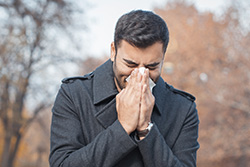
Just when you thought it was safe to go outside more hazards await: fall allergies. While most people associate allergies with springtime, the other peak season is right around the corner.
“While spring allergies are caused by tree pollen, fall allergies are caused by weeds, with ragweed being the biggest culprit,” says Dr. Soo Kwak, an allergy and immunology specialist with NewYork-Presbyterian Hudson Valley Hospital. “Ragweed season starts mid-August, with pollen counts rising throughout the course of the fall. Symptoms of ragweed allergy are similar to those caused by tree pollen — runny nose, itchy eyes, sneezing, scratchy throat and nasal congestion. The most symptomatic patients may not experience relief until after a hard frost.”
In addition to ragweed pollen, there are some lesser-known triggers for fall allergies. Unseasonably warm temperatures can make allergy symptoms last longer. Mold spores can be released when humidity is high, or if the weather is dry and windy. Many patients also find that their allergies are exacerbated by mold growth after leaves have fallen.
According to the American College of Allergy, Asthma and Immunology, allergies (also known as allergic rhinitis) are the sixth leading cause of chronic illness in the United States, with an annual cost in excess of $18 billion. More than 50 million Americans suffer from allergies each year.
Ways to get relief
There are a host of simple steps one can take along with medications designed to help alleviate the symptoms associated with allergies, regardless of the season. Advises Dr. Kwak, “Preemptive use of OTC or prescription medications early on in the season is more effective than playing catch-up after the season is in full swing.”
- Over-the-counter (OTC) saline sprays and drops: Saline sprays and artificial tears are most helpful in washing pollen out of the nose and eyes. They are effective when used after coming in from the outdoors.
- OTC nasal steroids: These sprays must be administered only at the recommended dosages, and when used, must be placed in the nose pointing to the ear. It often takes several days before the full benefits can be felt.
- Antihistamines and decongestants: Antihistamines reduce sneezing, sniffling, and itching by blocking histamine receptors in the body, while decongestants shrink the blood vessels in the nasal passageways to relieve congestion.
- Eye drops: Help relieve itchy, watery eyes.
- Monitor the pollen count: Pollen counts are usually highest between 4:00 a.m. and 8:00 a.m., so minimizing early-morning activities may help you get a jumpstart on a symptom-free day. Shower and shampoo after playing or working outside.
- Think “HEPA”: Purchase a portable high-efficiency particulate air (HEPA) filter or dehumidifier and vacuum the house every week with a vacuum cleaner that has a HEPA filter.
Finally, people should see an allergist when their quality of life is so impaired that they are unable to fully function and/or enjoy their normal lifestyle. Allergy injection therapy, also known as immunotherapy, can be very effective in preventing allergy symptoms and may decrease the need for daily medications. Says Dr. Kwak, “Patients with significant symptoms of allergies, allergic asthma and eczema, can benefit from allergy shots. Allergies can be very debilitating, but fortunately there are effective therapies available.”
Think you know a lot about seasonal allergies? Test your knowledge with our seasonal allergy quiz! Find an allergist by visiting doctors.nyp.org or by call 877-NYP-WELL.



